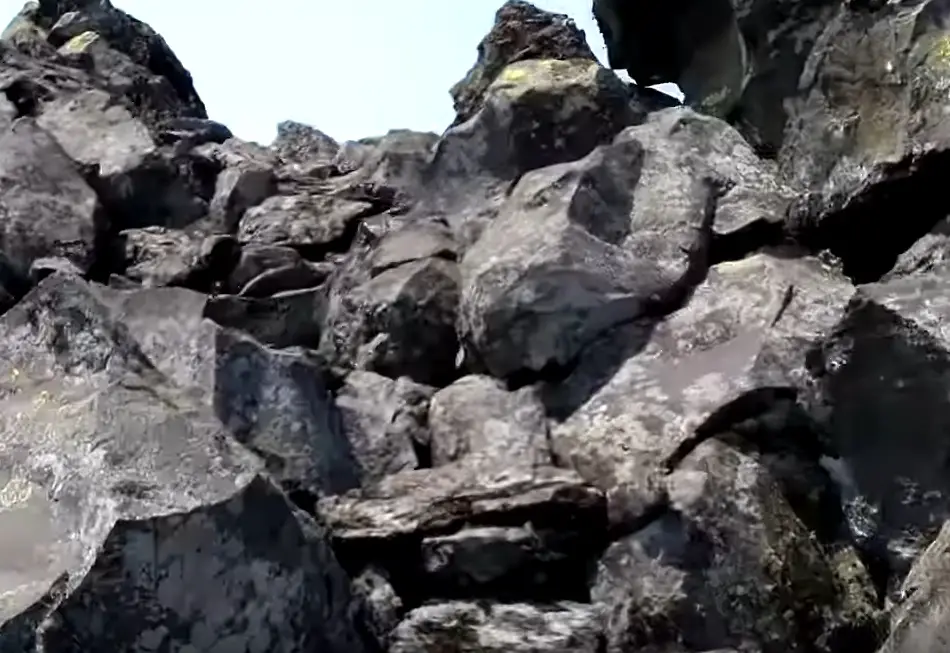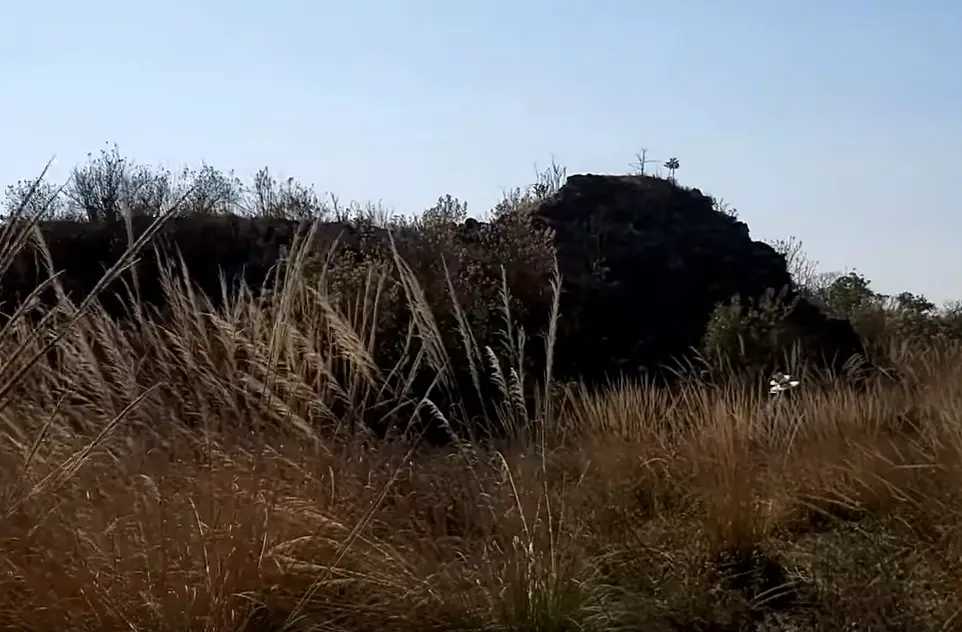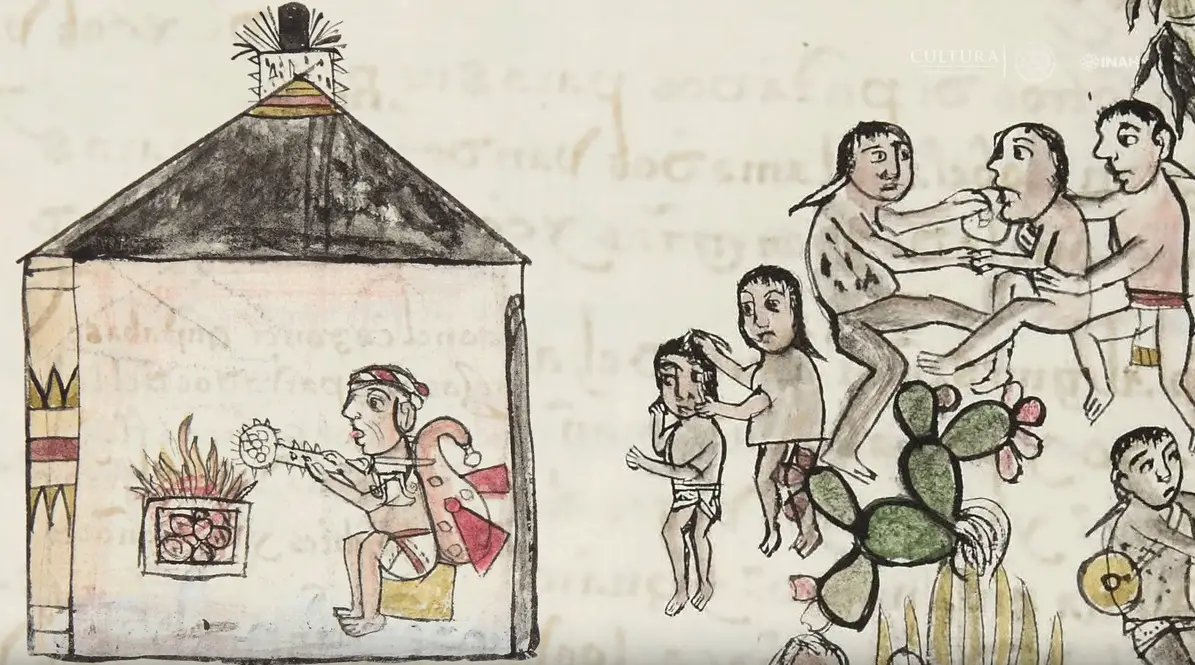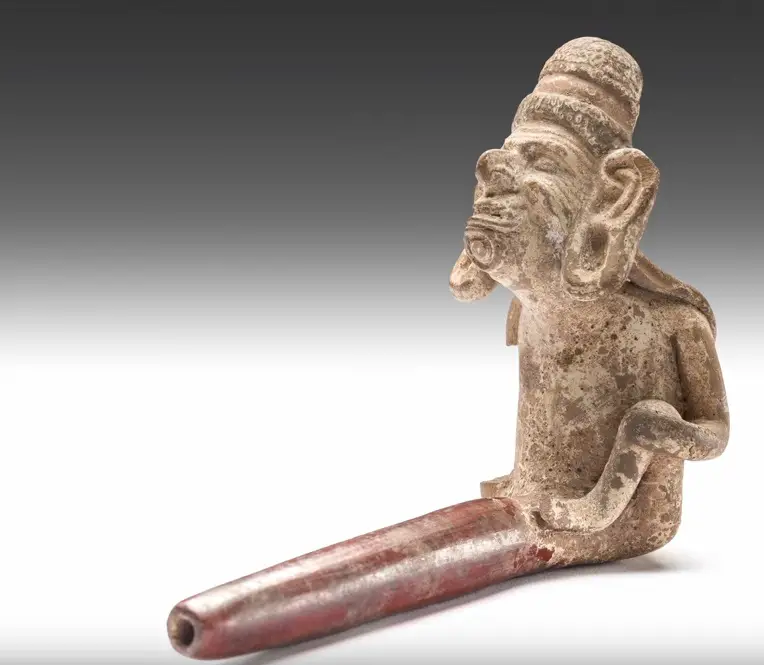 Between the years 1980 and 1990 the University of Paris sponsored many archaeological digs and surveys as a part of their “Michoacán Project,” located in the northern, often-overlooked, region of the Mexican state of Michoacán. The French archaeological teams investigated many sites but one of particular interest was named by the locals La Ciudad Perdida, literally “The Lost City,” in English. Covering an area of over 40 hectares, the Lost City is located in a very harsh and inhospitable place, a region called El Malpais Prieto, or “The Dark Badlands.” A series of old lava flows from nearby volcanoes give the landscape an otherworldly appearance. Black volcanic rock covers the area and very little grows there except for scrubby trees that provide little shade from the blistering sun and prickly pear cactus known throughout Mexico as nopal. In the middle of this seemingly uninhabitable zone, the early Tarascan civilization built a great city with pyramids, a civic-ceremonial center and palaces for the elites. Looking at the Ciudad Perdida the untrained eye sees piles of stones and one cannot imagine the magnificence that once was this city. As the site is remote and the environment is somewhat hostile to visitors, the Mexican government has so far made no attempt to restore the ruins or even fence them off. Visitors can come and go freely, along with treasure-hunters who have destroyed many of the ruined buildings looking for valuables that were not left behind. The rulers of the city abandoned it in the late 1200s to head south, taking pretty much everything with them. Archaeologists are still piecing the story together, but along with Tarascan oral histories they are starting to realize just how important this impressive city in the middle of a wasteland truly might have been.
Between the years 1980 and 1990 the University of Paris sponsored many archaeological digs and surveys as a part of their “Michoacán Project,” located in the northern, often-overlooked, region of the Mexican state of Michoacán. The French archaeological teams investigated many sites but one of particular interest was named by the locals La Ciudad Perdida, literally “The Lost City,” in English. Covering an area of over 40 hectares, the Lost City is located in a very harsh and inhospitable place, a region called El Malpais Prieto, or “The Dark Badlands.” A series of old lava flows from nearby volcanoes give the landscape an otherworldly appearance. Black volcanic rock covers the area and very little grows there except for scrubby trees that provide little shade from the blistering sun and prickly pear cactus known throughout Mexico as nopal. In the middle of this seemingly uninhabitable zone, the early Tarascan civilization built a great city with pyramids, a civic-ceremonial center and palaces for the elites. Looking at the Ciudad Perdida the untrained eye sees piles of stones and one cannot imagine the magnificence that once was this city. As the site is remote and the environment is somewhat hostile to visitors, the Mexican government has so far made no attempt to restore the ruins or even fence them off. Visitors can come and go freely, along with treasure-hunters who have destroyed many of the ruined buildings looking for valuables that were not left behind. The rulers of the city abandoned it in the late 1200s to head south, taking pretty much everything with them. Archaeologists are still piecing the story together, but along with Tarascan oral histories they are starting to realize just how important this impressive city in the middle of a wasteland truly might have been.
The Tarascans, also known as the Purépecha, remain a mystery to this day. The modern-day Tarascans still live in their ancestral homeland, territories comprising most of the Mexican state of Michoacán and smaller areas of surrounding states. Anthropologists puzzle over the origins of this seemingly unique people, as the Tarascans are unlike any other group in Mesoamerica. Their language is a linguistic isolate in Mexico and unrelated to any local languages. Some linguists have linked the Purépecha language to the Zuni language of Arizona and New Mexico, thousands of miles to the north, while others see similarities to Quechua, the language of the Inca of South America. The Tarascan building style suggests a link with the Inca, but those who propose a South  American connection do not know whether the Tarascans were once refugees or part of some ancient empire expansion that stretched north along the coast of the Americas. Archaeologists believe that the Tarascans emerged as the dominant culture in Michoacán around 1000 AD. Their political infrastructure coalesced over the next 300 years. According to Tarascan oral tradition, sometime around the year 1300 a visionary leader named Taríacuri decided to gather the Tarascan communities around Lake Pátzcuaro into one strong state and started conquering neighboring cities and towns. Legend has it that Taríacuri and his people came from the north, and this probably meant the northern part of what is now the state of Michoacán. A southern migration of people known in some oral and early written histories as the Purépecha-Chichimeca took place in the late 1200s which coincides with the abandonment of the Lost City found in the volcanic badlands. The Purépecha-Chichimeca people, also known as the Uacúsecha, still puzzle archaeologists and historians of ancient Mexico. Let’s take a look at them.
American connection do not know whether the Tarascans were once refugees or part of some ancient empire expansion that stretched north along the coast of the Americas. Archaeologists believe that the Tarascans emerged as the dominant culture in Michoacán around 1000 AD. Their political infrastructure coalesced over the next 300 years. According to Tarascan oral tradition, sometime around the year 1300 a visionary leader named Taríacuri decided to gather the Tarascan communities around Lake Pátzcuaro into one strong state and started conquering neighboring cities and towns. Legend has it that Taríacuri and his people came from the north, and this probably meant the northern part of what is now the state of Michoacán. A southern migration of people known in some oral and early written histories as the Purépecha-Chichimeca took place in the late 1200s which coincides with the abandonment of the Lost City found in the volcanic badlands. The Purépecha-Chichimeca people, also known as the Uacúsecha, still puzzle archaeologists and historians of ancient Mexico. Let’s take a look at them.
At the time of the Spanish Conquest of the Tarascan Empire in the first half of the 1500s, the emperor and the key rulers of the Tarascan State were chosen from families of the Uacúsecha. The Spanish assumed the Uacúsecha was a royal family or just an important class or noble line. Instead, they were a distinct Purépecha-speaking ethnic group that originated in the northern badlands area that had been part of the southern migration in the late 1200s. The Tarascan histories often call the Uacúsecha the Purépecha-Chichimeca. This is probably to indicate that these people came from the north, the fringes of the territory occupied by the nomadic Chichimec. Whether these people mixed with the Chichimeca is uncertain, and archaeologists are quick to point out that there is no evidence that the Purépecha-speaking Uacúsecha were related to the warlike nomads of the north who were called “Chichimeca” by most of the settled-down and more “civilized” people of central Mexico. The legends of the first ruler who unified the Tarascans around Lake Pátzcuaro, Taríacuri, claim that this great king’s mother was a daughter of the Tarascan ruler of Xarácuaro and his father was a Chichimeca warlord. Did these legends refer to Taríacuri’s father as “Chichimeca” because he was just a foreigner, or did he belong to the roving nomads of the northern  mountains and deserts? Modern historians are uncertain, but think his father most likely hailed from the Lost City or somewhere else in the Badlands and was not ethnically Chichimeca. For more information about the Chichimecs please see Mexico Unexplained Episode number 142: https://mexicounexplained.com//chichimeca-warriors-of-the-north/. The Tarascans of the more temperate Lake Patzcuaro region may have referred to their northern cousins, the Uacúsecha, as the “Purépecha-Chichimeca” to indicate that they came from the north. Perhaps they also put the “Chichimeca” tag on “Purépecha” to indicate that the Uacúsecha had some of the warlike characteristics of the Chichimecs. A people and their culture are products of their environment. Maybe the harsher environment of the Badlands produced a tougher and more aggressive people, and that may be the reason why the Uacúsecha moved south and eventually dominated their southern Tarascan neighbors. Another theory behind the use of the term “Purépecha-Chichimeca” is that the Uacúsecha came up with the name themselves to set themselves apart from the other Tarascans they ruled over. Although the Uacúsecha were pretty much culturally and linguistically identical to their southern Tarascan neighbors whom they would come to dominate, they made themselves into “the other,” something distinct and special, to legitimize their right to rule.
mountains and deserts? Modern historians are uncertain, but think his father most likely hailed from the Lost City or somewhere else in the Badlands and was not ethnically Chichimeca. For more information about the Chichimecs please see Mexico Unexplained Episode number 142: https://mexicounexplained.com//chichimeca-warriors-of-the-north/. The Tarascans of the more temperate Lake Patzcuaro region may have referred to their northern cousins, the Uacúsecha, as the “Purépecha-Chichimeca” to indicate that they came from the north. Perhaps they also put the “Chichimeca” tag on “Purépecha” to indicate that the Uacúsecha had some of the warlike characteristics of the Chichimecs. A people and their culture are products of their environment. Maybe the harsher environment of the Badlands produced a tougher and more aggressive people, and that may be the reason why the Uacúsecha moved south and eventually dominated their southern Tarascan neighbors. Another theory behind the use of the term “Purépecha-Chichimeca” is that the Uacúsecha came up with the name themselves to set themselves apart from the other Tarascans they ruled over. Although the Uacúsecha were pretty much culturally and linguistically identical to their southern Tarascan neighbors whom they would come to dominate, they made themselves into “the other,” something distinct and special, to legitimize their right to rule.
The Uacúsecha or Purépecha-Chichimeca didn’t always live in a harsh environment. The northern part of Michoacán was once incredibly wet, and the lakes, rivers and marshes overflowed and flooded agricultural areas sometime after 1000 AD. During this intense and prolonged wet period, the Purépecha-Chichimeca abandoned the northern lowlands and lake shores and moved into the badlands, constructing the Lost City in the Malpais Prieto. Archaeologists have uncovered many roads and footpaths leading outward from the city, one is even nicknamed El Camino Real, or “The Royal Road.” Some of these roads linked the site with smaller settlements nearby which were probably aligned with the city politically. Many of the roads go beyond and lead out of the Badlands. The Lost City served primarily as a trading hub and the elites who profited from this overland commerce built up the great city that would eventually include its yacatas or pyramidal temples and its royal residences. All buildings at the site are built from black volcanic stone, which makes the Lost City of the Tarascans somewhat unique among ancient Mexican ruins. Common areas in the city were pounded down out of the volcanic rock, as were sites for homes. There is some evidence of gardens in the plazas of the elite residences and soil must have been brought in from outside the Badlands so that many varieties of plants and flowers could grow. The largest yacata in the Lost City today looks like just a pile of stones and from a short distance seems more like a hill covered in nopales instead of the impressive building it once was. Priests and nobles inside this temple once maintained eternal fires lit to their sun god, Curicaueri. When they abandoned the Lost City, the Uacúsecha took their powerful sun god with them and Curicaueri would be integrated into the gods of their southern cousins. In the Tarascan religion, this great sun god from the north would become the protector of all Tarascan people and the later nobility of the Tarascan Empire were said to be in direct communication with him. In addition to the important temple to the sun god, many fortifications also exist at the Ciudad Perdida which may indicate prolonged warfare with invading northern tribes. Archaeologists as of now cannot pinpoint an exact date of the city’s founding but ancient petroglyphs or chipped-out rock carvings in and around the city point to the location’s longstanding importance. The site of the Lost City may have been a place of pilgrimage hundreds of years before a large permanent population relocated there after the climate became wetter. Rock art depicting animals, humans and celestial figures are found around the ruins and pre-date the site by an unknown amount of centuries. As mentioned earlier, the Lost City is not protected, and people have taken away many of the stones containing the beautiful old petroglyphs or they have become otherwise destroyed or defaced with modern intrusion.
 Some archaeologists theorize that long distance trade with the Toltecs gave the Uacúsecha or Purépecha-Chichimeca the very idea of having an organized, highly centralized state. The Lost City together with its surrounding settlements in the Badlands may have been the very beginnings of the Tarascan Empire. As previously stated, the Uacúsecha or Purépecha-Chichimeca moved south to the Lake Patzcuáro region and began allying with other Tarascan people to create the empire that would be headed by them for over three centuries. Unlike the Aztecs, the Tarascans never claimed Toltec descent, and at the time of the Spanish Conquest the Tarascans even claimed that some Aztec practices inherited from the Toltecs were primitive or beneath them. The idea of a highly centralized and extremely organized empire, though, most likely did come from Toltecs, as the Lost City had direct and extended contact with the Toltec Civilization long before the Aztecs arrived in central Mexico. There was no such type of political organization in Western Mexico before, so it may have all started a little bit north of the traditional Tarascan homeland in what is now the Badlands called Malpais Prieto.
Some archaeologists theorize that long distance trade with the Toltecs gave the Uacúsecha or Purépecha-Chichimeca the very idea of having an organized, highly centralized state. The Lost City together with its surrounding settlements in the Badlands may have been the very beginnings of the Tarascan Empire. As previously stated, the Uacúsecha or Purépecha-Chichimeca moved south to the Lake Patzcuáro region and began allying with other Tarascan people to create the empire that would be headed by them for over three centuries. Unlike the Aztecs, the Tarascans never claimed Toltec descent, and at the time of the Spanish Conquest the Tarascans even claimed that some Aztec practices inherited from the Toltecs were primitive or beneath them. The idea of a highly centralized and extremely organized empire, though, most likely did come from Toltecs, as the Lost City had direct and extended contact with the Toltec Civilization long before the Aztecs arrived in central Mexico. There was no such type of political organization in Western Mexico before, so it may have all started a little bit north of the traditional Tarascan homeland in what is now the Badlands called Malpais Prieto.
Much work is yet to be done at the Lost City of the Tarascans. As this inhospitable area is not frequently visited, the Mexican government has done little to protect the site and has no plans to secure it in the foreseeable future. There are still many mysteries to be revealed at this important place, and the complete story of the early days of the Tarascan Empire is yet to be told.
REFERENCES
Coe, Michael D. Mexico: From the Olmecs to the Aztecs. New York: Thames and Hudson, 1994. We are an Amazon affiliate. Buy the book on Amazon here: https://amzn.to/3013VQm
Paredes M., Carlos. “Sistemas de intercambio en el estado tarasco: Notas para su estudio.” In Origen y Desarrollo en el Occidente del Mexico, Brigitte Boehm de Lameiras y Phil C. Weigand, coord. Pp. 295-305. Zamora, Mich.: El Colegio de Michoacán. (In Spanish)
INAH Web site (In Spanish)
